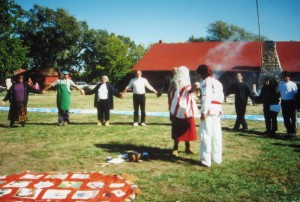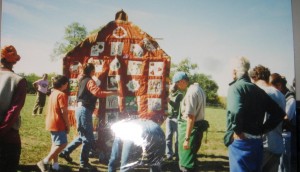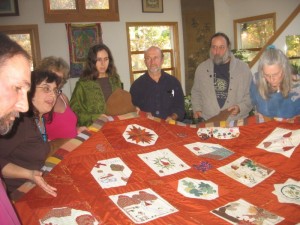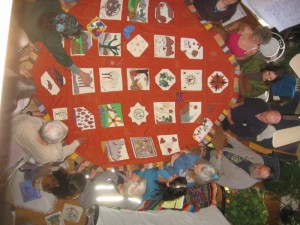 Started by two women on the organizing committee of the 1st Continental Bioregional Congress (called the North American Bioregional Congress at the time) that took place in the borderland between the Ozark and prairie bioregionals (near Kansas City, MO) in 1984. The women, Connie Grand (lead quiltess) and Ella Alford (supporter of the project through participation, funding and spirit), sent fabric out a call for people throughout the continent to make squares, and then sent out fabric to all who answered the call, asking for each region to send back a patch that spoke of the culture and ecology of their home place.
Started by two women on the organizing committee of the 1st Continental Bioregional Congress (called the North American Bioregional Congress at the time) that took place in the borderland between the Ozark and prairie bioregionals (near Kansas City, MO) in 1984. The women, Connie Grand (lead quiltess) and Ella Alford (supporter of the project through participation, funding and spirit), sent fabric out a call for people throughout the continent to make squares, and then sent out fabric to all who answered the call, asking for each region to send back a patch that spoke of the culture and ecology of their home place.
Interestingly, the first squares seemed to be mostly made by women from across the continent. This spoke to an imbalance in gender roles that was noticed even more strongly when the congress met. Men would dominate the conversation by habit, and quickly the Congress decided that some action needed to be taken to help create a space open for all to speak and share. The quilt played a central role in this strategy, as the men, who wanted to heal the rift and create balance as much as the women, sat down to sew the prices of the quilt, brought from the four corners of North America together into one whole. Working together they assembled the turtle island quilt and helped break the isolation patterns passed
down by our culture. In addition to the ceremonial sewing of the quilt several other decisions helped make the Congress Plenary Sessions more open to the feminine energy it seemed to be lacking. David Haenke remembers of that time, “I have been going to endless numbers of assemblies for over 40
years, most of them ecological in theme, and I have never seen anything approaching the level of  high-functioning mutual respect that’s present at the Congress. Of course this didn’t happen without a great deal of soul deep hard work of impeccable good intent from all principals, the effort initiated by the women of NABC I, of which the quilt story is one salient element.”
high-functioning mutual respect that’s present at the Congress. Of course this didn’t happen without a great deal of soul deep hard work of impeccable good intent from all principals, the effort initiated by the women of NABC I, of which the quilt story is one salient element.”
The quilt has played a central role in each congress, and has traveled across the continent and back, being hosted at each of the 9 previous congresses listed below:
• The Ozark Mountains (Arkansas, 1984)
• The Great Lakes Bioregion (Michigan, 1986)
• Cascadia (British Columbia, 1988)
• Gulf of Maine (Maine, 1990)
• Edwards Plateau (Texas, 1992)
• Ohio River Valley (Kentucky, 1994)
• Cuahunahuac (Mexico, 1996; this was also a hemispheric gathering)
• The Prairie (Kansas/Kansas Area Watershed/KAW, 2002)
• Katuah (Southern Appalachians, at Earthaven Ecovillage, 2005.
Each one of these convenings has been put on by a bioregional group from the host region. In a sense, from its beginning in 1984, there has been just one congress, going in and out of session on that average of every 2 years, for nearly 20 years, maintaining its continuity between assemblies through secretariats and coordinating councils. Each convening of the Continental Congress has been a landmark  event, widened our vision, and deepened our commitment to bioregionalism.
event, widened our vision, and deepened our commitment to bioregionalism.
Now the quilt is hanging in the community center of The Farm, a community with a deep history of mindfulness, connection with the land, and a global network of positive influence.
Welcome Home, to the Tenth Continental Bioregional Congress on The Farm
Written by Greg Landua with information from Caryn Mirriam-Goldberg and David Haenke. Pictures by Ken Lassman: Two on top from CBC 8 on the Prairie in 2002 (in Kansas), plus one on quilt detail, and two bottom ones show presentation of quilt from CBC Coordinating Council to CBC Site Committee in fall of 2008 at The Farm.